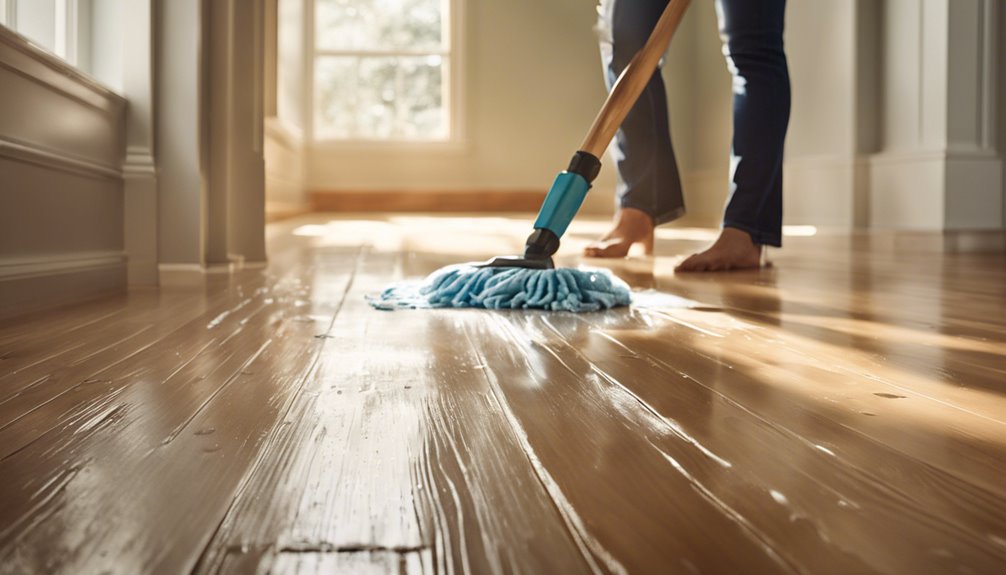To wash engineered hardwood floors, you'll need a microfiber mop and a pH-balanced cleaner designed for hardwood. Start by removing furniture and rugs to free up space. Sweep or vacuum using a soft-bristle broom or a hard-surface vacuum, avoiding those with beater bars. Mix your cleaner in a bucket according to instructions, ensuring it stays within a pH of 6 to 8. Mop the floor damply, avoiding excess water, and allow it to dry completely. Regular maintenance keeps your floors looking new. Explore how to enhance your cleaning routine for long-lasting results.
Gather Necessary Supplies
To effectively clean your engineered hardwood floors, it is essential to gather the right supplies. Start with a microfiber mop, which won't scratch the surface, ensuring floor protection. For cleaning products, opt for a pH-balanced cleaner specifically designed for engineered hardwood. Avoid harsh chemicals that can damage the finish. You'll also need a bucket for dilution and a soft-bristle broom to sweep away debris before mopping. Consider using a spray bottle for targeted application of cleaning solutions. Additionally, have a soft cloth handy for any stubborn stains. Keeping these supplies organized will streamline your cleaning process and maintain the beauty of your floors, allowing you the freedom to enjoy them without worry.
Prepare the Floor
Before you start cleaning, it's important to prepare the floor properly. Begin with a thorough floor assessment; check for any damage, dirt, or debris that could affect the cleaning process. Look for scratches, dents, or areas where moisture might have accumulated. Knowing the condition of your engineered hardwood helps you determine the right cleaning approach.
Next, engage in surface preparation by removing any rugs, furniture, or obstacles. This step guarantees you can access every part of the floor without hindrance. If your floor has any sticky residue or stains, consider spot-treating those areas before proceeding. Proper preparation not only enhances the effectiveness of your cleaning but also extends the life of your engineered hardwood, allowing you to enjoy its beauty longer.
Sweep or Vacuum
When maintaining engineered hardwood floors, selecting the right tools for sweeping or vacuuming is essential. You should aim to clean these surfaces regularly to prevent dirt and debris buildup, which can damage the finish over time. Consider using a soft-bristle broom or a vacuum with a hardwood floor setting for ideal results.
Choose Appropriate Tools
Choosing the right tools for cleaning engineered hardwood floors is essential for maintaining their appearance and longevity. For effective floor care, you'll want to use either a soft-bristle broom or a vacuum designed for hard surfaces. A broom helps to gather larger debris without scratching the surface, while a vacuum can efficiently remove dust and dirt trapped in crevices. Avoid using vacuums with beater bars, as they can damage the finish. If you opt for a broom, make certain it's clean and free of grit to prevent scratches. Regular use of these cleaning tools will keep your floors looking pristine and extend their life. Remember, the right choice in tools is key to achieving a clean, polished look.
Frequency of Cleaning
To keep your engineered hardwood floors looking their best, it's important to establish a regular cleaning routine. Aim to sweep or vacuum at least once a week to remove dirt and debris that can lead to scratches. If you have pets or high foot traffic, consider increasing this frequency to two or three times a week. Incorporate your cleaning schedule with seasonal maintenance; for instance, during spring or fall, perform a deeper clean by using a damp mop and a suitable cleaner. Always guarantee the mop is well-wrung to avoid excess moisture. By adhering to this routine, you'll maintain the integrity of your floors while allowing them to shine, providing you the freedom to enjoy your space worry-free.
Choose the Right Cleaner
Selecting the right cleaner for your engineered hardwood floors is essential for maintaining their appearance and longevity. You can opt for natural cleaners, which are eco-friendly and often safer for pets and children. Look for solutions that contain ingredients like vinegar or essential oils, avoiding harsh chemicals that can damage the finish. Alternatively, if you prefer commercial products, verify they're specifically formulated for engineered hardwood. Check labels for pH balance and compatibility with your floor's surface. Avoid abrasive cleaners or those containing wax, as they can leave a residue and dull the finish. By choosing wisely, you'll preserve the beauty of your floors while enjoying the freedom to clean effectively and efficiently.
Mopping Techniques
When mopping engineered hardwood floors, selecting the right mop is essential to avoid damage. You should also consider ideal cleaning solutions that are safe for the finish and effective in removing dirt. Finally, understanding mopping frequency guidelines will help maintain the floor's appearance without causing wear.
Choosing the Right Mop
How can you guarantee that your engineered hardwood floors are cleaned effectively without causing damage? Choosing the right mop is essential. Opt for mop types that are safe for hardwood, such as microfiber or sponge mops, as they're gentle yet effective. Avoid string mops, which can retain excess water and lead to warping.
When selecting mop materials, prioritize those that are soft and absorbent, ensuring they won't scratch your floor's surface. Microfiber mops are ideal because they trap dirt and dust without leaving residue. Additionally, consider adjustable or flat mops for ease of maneuverability in tight spaces. With the right mop, you'll maintain the beauty of your engineered hardwood floors while achieving a thorough clean.
Optimal Cleaning Solutions
While it's crucial to have the right mop, using ideal cleaning solutions is equally important for maintaining engineered hardwood floors. Opt for eco-friendly cleaners specifically formulated for hardwood surfaces. These products not only reduce your environmental impact but also guarantee your floors remain free from harmful chemicals. Always check the pH balance of the cleaner; an ideal range is between 6 and 8 to prevent damage. Avoid excess moisture, as engineered hardwood is sensitive to water. When mopping, use a damp microfiber pad with your chosen cleaner, guaranteeing even coverage without over-saturating the floor. This approach will help preserve the finish and beauty of your engineered hardwood while making cleaning efficient and safe for you and your home.
Mopping Frequency Guidelines
After selecting the right cleaning solution, establishing a regular mopping frequency is key to maintaining the appearance and durability of your engineered hardwood floors. Generally, mopping once every two weeks is sufficient for most households. However, if you have pets or high foot traffic areas, consider mopping weekly to prevent dirt buildup.
When mopping, use damp mopping methods rather than soaking your floors, as excess water can damage the wood's finish. Always make certain your mop is clean to avoid transferring grime. Additionally, be attentive to seasonal changes; during spring or fall, you might need to adjust your frequency due to increased dirt or pollen. Consistent floor care prolongs the life of your engineered hardwood, making sure it remains beautiful and resilient.
Drying and Maintenance Tips
To guarantee your engineered hardwood floors maintain their beauty and durability, proper drying and maintenance are essential. After cleaning, employ effective drying techniques, like using a microfiber cloth or a fan to expedite the drying process. Avoid allowing water to pool, as moisture can damage the flooring. For ongoing care, establish maintenance routines that include regular sweeping or vacuuming to remove dirt and debris. Additionally, consider using a pH-neutral cleaner designed for hardwood, applied sparingly. Protect your floors from scratches and dents by placing rugs at entryways and using furniture pads. Finally, periodically check for any signs of wear or damage, addressing them promptly to ascertain your floors stay looking their best.
Frequently Asked Questions
Can I Use a Steam Mop on Engineered Hardwood Floors?
You might be wondering if you can use a steam mop on engineered hardwood floors. While steam mops offer benefits like sanitizing and deep cleaning, they also pose risks. The heat and moisture can damage the adhesive that holds the layers together, leading to warping or separation. It's best to avoid steam mops and opt for a cleaner specifically designed for engineered hardwood to guarantee your floors remain in great condition.
How Often Should I Clean My Engineered Hardwood Floors?
Did you know that regular cleaning can extend the lifespan of your engineered hardwood floors by up to 30%? To maintain their beauty, you should clean them at least once a week, using a gentle cleaner. For high-traffic areas, consider increasing your cleaning frequency. Incorporating maintenance tips like avoiding excess water and using felt pads under furniture will help keep your floors looking pristine and enhance your home's overall aesthetic.
Are There Specific Cleaners to Avoid for Engineered Hardwood?
When it comes to maintaining your engineered hardwood floors, you'll want to avoid cleaners with harsh ingredients like ammonia, bleach, or wax. These can damage the finish and compromise the surface. Instead, opt for pH-balanced cleaners specifically designed for hardwood. Regular floor maintenance is key, so make sure you're using the right products to keep your floors looking pristine without risking any long-term damage. Always check the ingredient list before purchasing.
Is It Safe for Pets to Walk on Freshly Cleaned Floors?
You might wonder about pet safety on freshly cleaned floors. It's essential to guarantee the floor's completely dry before letting your pets walk on it. Wet surfaces can be slippery, increasing the risk of slips and falls for both pets and humans. Additionally, some cleaning products could leave residues that might not be safe for your furry friends. Always check the drying time and consider using pet-friendly cleaners to guarantee their safety.
How Do I Remove Tough Stains From Engineered Hardwood?
To remove tough stains from engineered hardwood, you'll want to employ effective stain removal techniques. Start by identifying the stain type; for water-based stains, a damp cloth with mild soap often suffices. For oil-based stains, try using a mixture of vinegar and water. Always test any cleaning solution in an inconspicuous area first to confirm it won't damage the finish. Remember, regular maintenance can prevent tough stains from becoming a problem in the first place.




